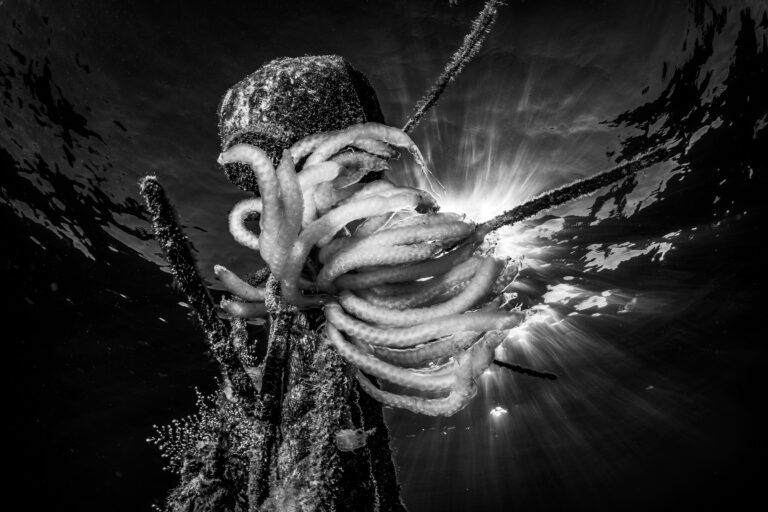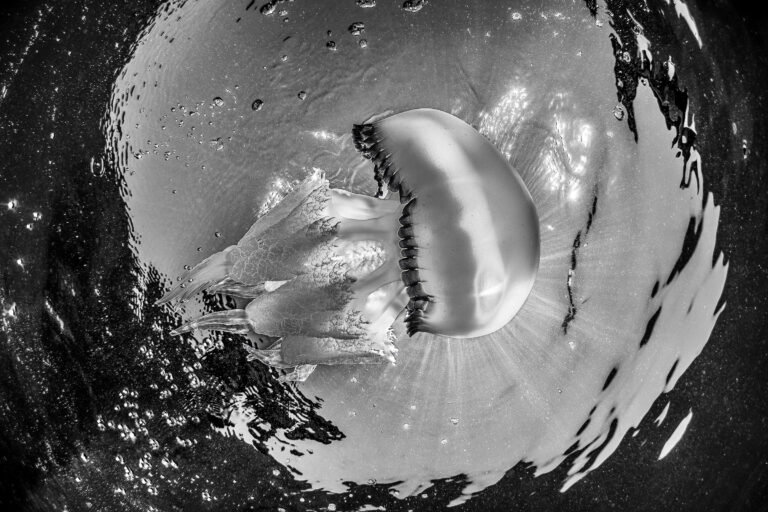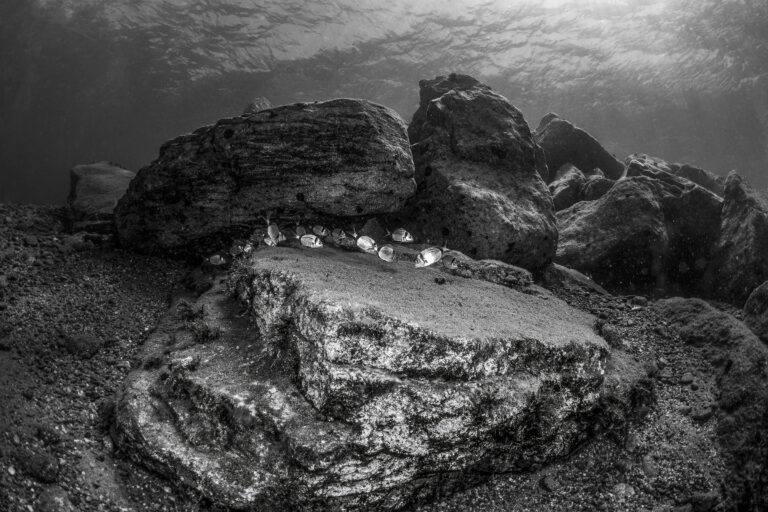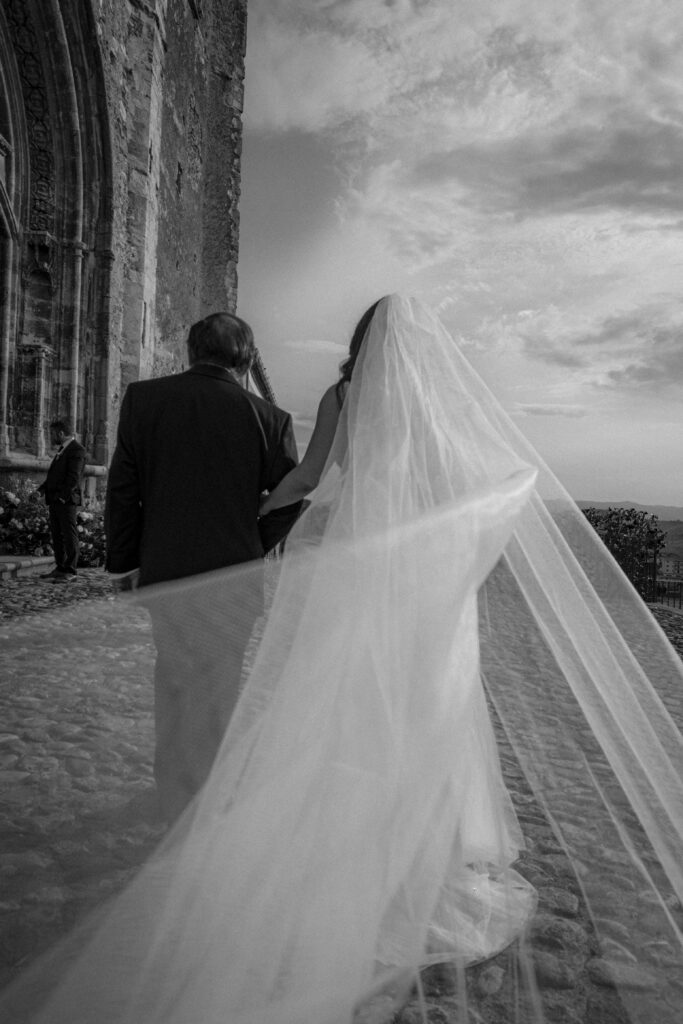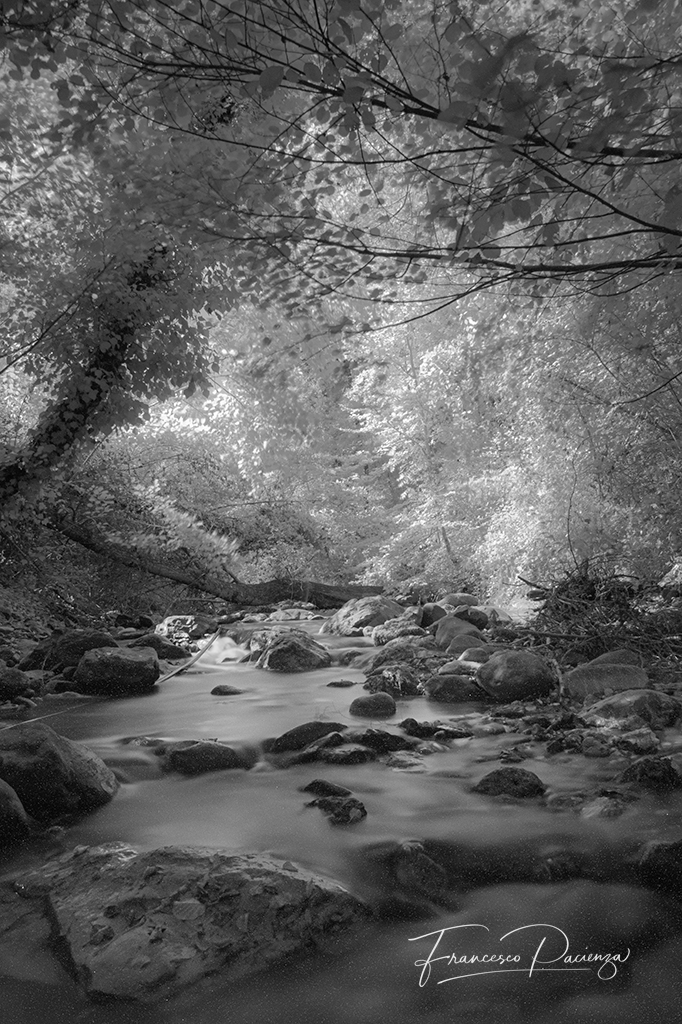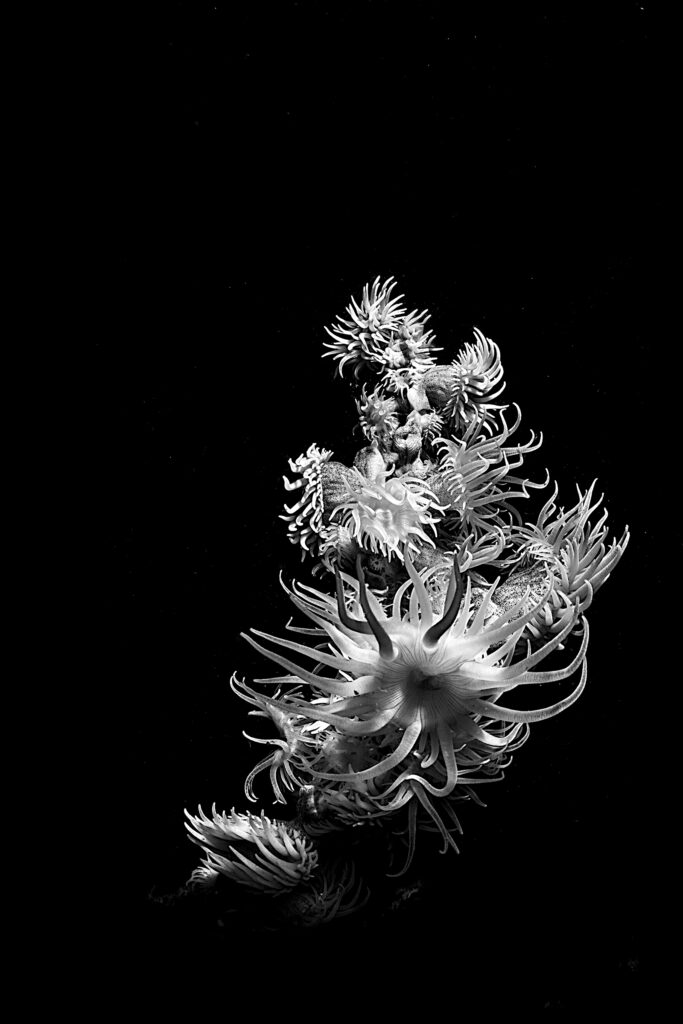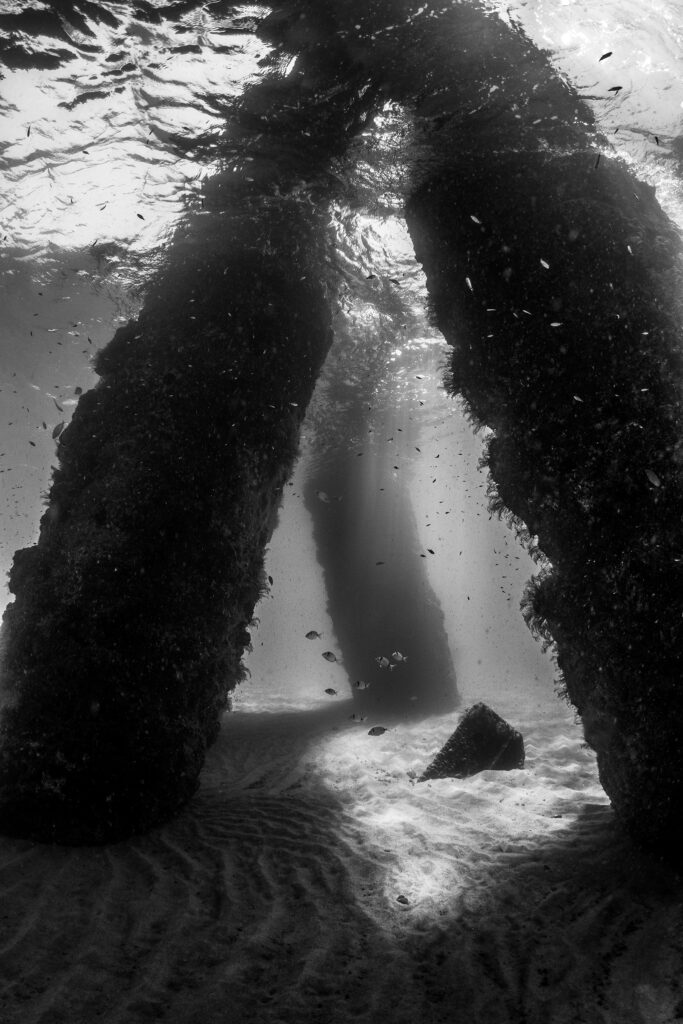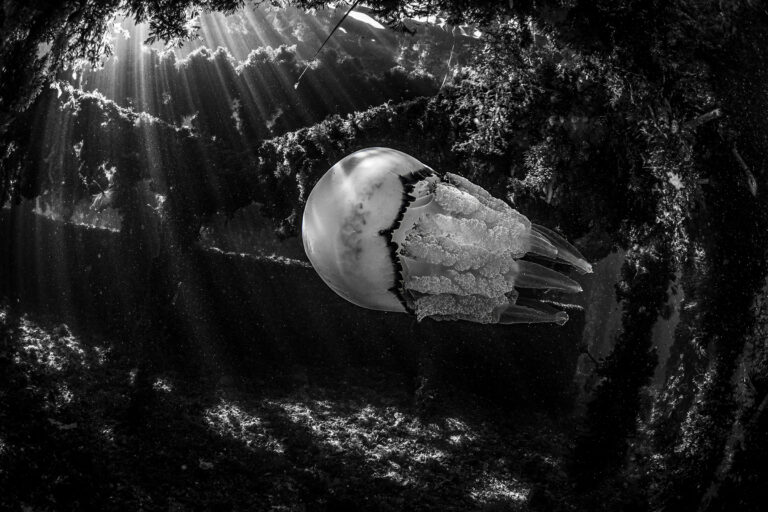Nelle fotografie a colori c’è già tutto. Una foto in bianco e nero invece è come un’illustrazione parziale della realtà. Chi la guarda, deve ricostruirla attraverso la propria memoria che è sempre a colori, assimilandola a poco a poco. C’è quindi un’interazione molto forte tra l’immagine e chi la guarda. La foto in bianco e nero può essere interiorizzata molto di più di una foto a colori, che è un prodotto praticamente finito. (Sebastiao Salgado)
Agli inizi era il Bianco e Nero e tale restò con le sue infinite varianti per oltre mezzo secolo. Nel Bianco e Nero le forme e i volumi sono esaltati dall’alternanza delle luci e delle ombre. Luce ed ombra, due facce di una stessa medaglia: l’una non potrebbe esistere senza l’altra. L’alternanza, su di un corpo, della luce e dell’ombra conferisce ad esso volume e tridimensionalità. La luce illumina, riscalda, “brucia”, indica una direzione, suscita un’emozione, crea immagini sempre diverse; al suo opposto vi è l’ombra che nasconde, enfatizza, che crea suspense, che racconta la luce.
Quando la fotografia era in Bianco e Nero l’atmosfera di una foto era demandata esclusivamente al sapiente gioco e dosaggio delle luci e delle ombre, la composizione acquistava un valore aggiunto. L’ombra può essere dura o morbida, l’ombra può creare sensazioni di forza, nel caso di ombre molto marcate, o di gentilezza, nel caso di ombre molto morbide ed avvolgenti. Una composizione senza ombre diventa piatta, perde profondità, diventa anonima
At the beginning it was Black and White and it remained so with its infinite variations for over half a century. In B&W the shapes and volumes are enhanced by the alternation of lights and shadows. Light and shadow, two sides of the same coin: one could not exist without the other. The alternation, on a body, of light and shadow gives it volume and three-dimensionality. Light illuminates, heats, “burns”, indicates a direction, arouses an emotion, creates ever-changing images; at its opposite there is the shadow that hides, emphasizes, that creates suspense, that tells the light.
When photography was in Black and White, the atmosphere of a photo was entrusted exclusively to the skilful play and dosage of lights and shadows, the composition acquired an added value. The shadow can be hard or soft, the shadow can create feelings of strength, in the case of very marked shadows, or of gentleness, in the case of very soft and enveloping shadows. A composition without shadows becomes flat, loses depth, becomes anonymous.
Occorre saper vedere in Bianco e Nero visto che siamo circondati dai colori: nel cinema e anche nella fotografia si faceva ricorso ad uno speciale lentino che, avvicinato all’occhio, rimuoveva il colore per qualche secondo permettendo così di poter valutare la gamma dei grigi della scena che si aveva davanti agli occhi.
Nel Bianco e Nero la luce è strettamente connessa con l’ambiente e l’atmosfera che si vuole descrivere. Il racconto delle emozioni e sensazioni racchiuse nell’immagine fotografica non subiscono più la mediazione emotiva data dal colore e dai suoi contrasti negli abbinamenti, le emozioni e le sensazioni, che poi costituiscono il vero fascino di una foto in BN, sono tutte legate ai volumi che la luce disegna e alla materia che la luce riveste e rivela. La luce assume un ruolo ed un significato che va aldilà del semplice concetto di illuminare, diventa elemento caratterizzante della composizione fotografica, diventandone parte determinante.
It is necessary to know how to see in Black and White since we are surrounded by colors: in cinema and also in photography, a special lens was used which, when brought closer to the eye, removed the color for a few seconds, thus allowing to evaluate the range of grays of the scene that you had before your eyes.
In B&W, light is closely connected with the environment and the atmosphere that you want to describe. The story of the emotions and sensations contained in the photographic image no longer undergoes the emotional mediation given by the color and its contrasts in the combinations, the emotions and sensations, which then constitute the true charm of a B&W photo, are all linked to the volumes that the light draws and to the matter that the light covers and reveals. Light takes on a role and a meaning that goes beyond the simple concept of illuminating, it becomes a characterizing element of the photographic composition, becoming a determining part of it.
Il bianco ed il nero hanno un loro significato, una loro motivazione e quando si cerca di eliminarli, il risultato è un errore. La cosa più logica è di considerarli come dei neutri: il bianco come la più luminosa unione dei rossi, azzurri, gialli più chiari, e il nero, come la più luminosa combinazione dei più scuri rossi, azzurri e gialli; affermava il noto pittore del colore Vincent Van Gogh.
Sono in molti a pensare che togliere il colore costituisce una perdita di informazioni. In realtà questa apparente “perdita” contribuisce a rafforzare molto di più il senso e la comunicatività dell’immagine fotografica. Una foto a colori rischia di essere troppo realistica, lascia poco spazio all’immaginazione, in alcuni casi è proprio una copia del reale e spesso, con la orribile tendenza alla estrema saturazione o stravolgimento dei colori in nome di una presunta scelta artistica. Eliminando il colore si può arrivare all’essenziale.
Il Bianco e Nero Consente maggiore chiarezza; ha la capacità di cogliere il carattere di una persona sul suo viso segnato, di esprimere l’essenza di un luogo attraverso il gioco di luci in un paesaggio, o fermare un attimo fuori dal tempo sullo sfondo di un’azione nella fotografia naturalistica. Il Bianco e Nero aiuta a estrarre il messaggio; aiuta a vedere oltre la copertura del colore l’essenza di una cosa, una persona, o un luogo. E’ fuori dal tempo e per questo non è mai “superato”, obsoleto ma conserva una sua forte valenza interpretativa artistica.
The black and the white have their own meaning, their own motivation and when you try to eliminate them, the result is a mistake. The most logical thing is to consider them as neutrals: white as the brightest union of the lightest reds, blues, yellows, and black, as the brightest combination of the darkest reds, blues and yellows; stated the well-known painter of color Vincent Van Gogh.
Many people think that removing color is a loss of information. In reality, this apparent “loss” helps to strengthen the sense and communicativeness of the photographic image much more.A color photo risks being too realistic, it leaves little room for the imagination, in some cases it is a copy of the real and often, with the horrible tendency to extreme saturation or distortion of colors in the name of an alleged artistic choice. By eliminating the color you can get to the essential.
B&W allows for greater clarity; has the ability to capture the character of a person on his marked face, to express the essence of a place through the play of lights in a landscape, or to stop for a moment out of time against the backdrop of an action in nature photography. Black and White helps to extract the message; it helps to see beyond the coverage of color the essence of a thing, a person, or a place. It is out of time and for this reason it is never “outdated”, obsolete but retains its strong artistic interpretative value.
Qualunque sia il genere di fotografia con il Bianco e Nero essa acquista una maggiore profondità spaziale grazie ai gradienti di grigio derivanti dalla particolare atmosfera che si interpone tra i soggetti fotografati e l’osservatore.
Se il colore è più immediato nella lettura degli elementi che compongono una fotografia, il Bianco e Nero richiede una maggiore e particolare attenzione ma il coinvolgimento emozionale sarà sicuramente più rilevante.
Whatever the kind of photography with B&W it acquires greater spatial depth thanks to the gray gradients deriving from the particular atmosphere that is interposed between the photographed subjects and the observer.
If color is more immediate in the reading of the elements that make up a photograph, Black and White requires greater and particular attention but the emotional involvement will certainly be more relevant.
In Bianco e Nero suggerisci (atmosfere, emozioni, pensieri, ricordi), a colore affermi lasciando poco spazio alla immaginazione e al ricordo.
Sono fermamente convinto che le fotografie in Bianco e Nero siano generalmente più tranquille e misteriose di quelle a colori.
Il Bianco e Nero ispira l’immaginazione dell’osservatore e lo porta a completare la fotografia con l’immaginazione. Il bianco e nero non cerca di competere con il mondo esterno. Per questo persiste molto più a lungo nella nostra memoria visiva.
In Black&White you suggest (atmospheres, emotions, thoughts, memories), in color you say leaving little room for imagination and memory.
I strongly believe that B&W photographs are generally quieter and more mysterious than color ones.
B&W inspires the observer’s imagination and leads him to complete the photograph with his imagination. B&W doesn’t try to compete with the outside world. This is why it persists much longer in our visual memory.
Come già detto all’inizio una foto in Bianco e Nero deve essere già pensata tale; occorre vedere la scena in BN prima ancora di fare Click: una foto pensata è ben diversa da una trasformata dopo essere stata scattata.
Per convincervi di questa mia affermazione vi invito ad eseguire il processo mentale di pensare e poi scattare la foto in Bianco e Nero (disposizione delle luci, scala dei grigi, ombre e composizione basata sulle forme e i volumi) e poi sviluppare il file RAW a colori: resterete stupiti dal risultato che otterrete.
As already said at the beginning, a Black&White photo must already be thought of as such; it is necessary to see the scene in B&W even before clicking: a photo thought is very different from a transformed one after having been taken.
To convince you of this statement, I invite you to carry out the mental process of thinking and then shoot the photo in Black&White (arrangement of lights, grayscale, shadows and composition based on shapes and volumes) and then develop the RAW file in color: you will be amazed from the result you will get.
I Picture Control di Nikon sono delle impostazioni che ci consentono di produrre immagini fotografiche senza dover ricorrere a software esterni di sviluppo, se non per apportare piccole migliorie.
Questo Picture Control l’ho pensato e realizzato per ottenere foto in Bianco&Nero, direttamente in macchina, con l’utilizzo di luce flash mista a luce ambiente nella fotografia subacquea. Un omaggio per tutti voi.
Nikon’s Picture Controls are settings that allow us to produce photographic images without having to resort to external development software, except to make small improvements.
This Picture Control was designed and built to obtain Black & White photos, directly in the camera, with the use of flash light mixed with ambient light in underwater photography. A tribute for all of you.

